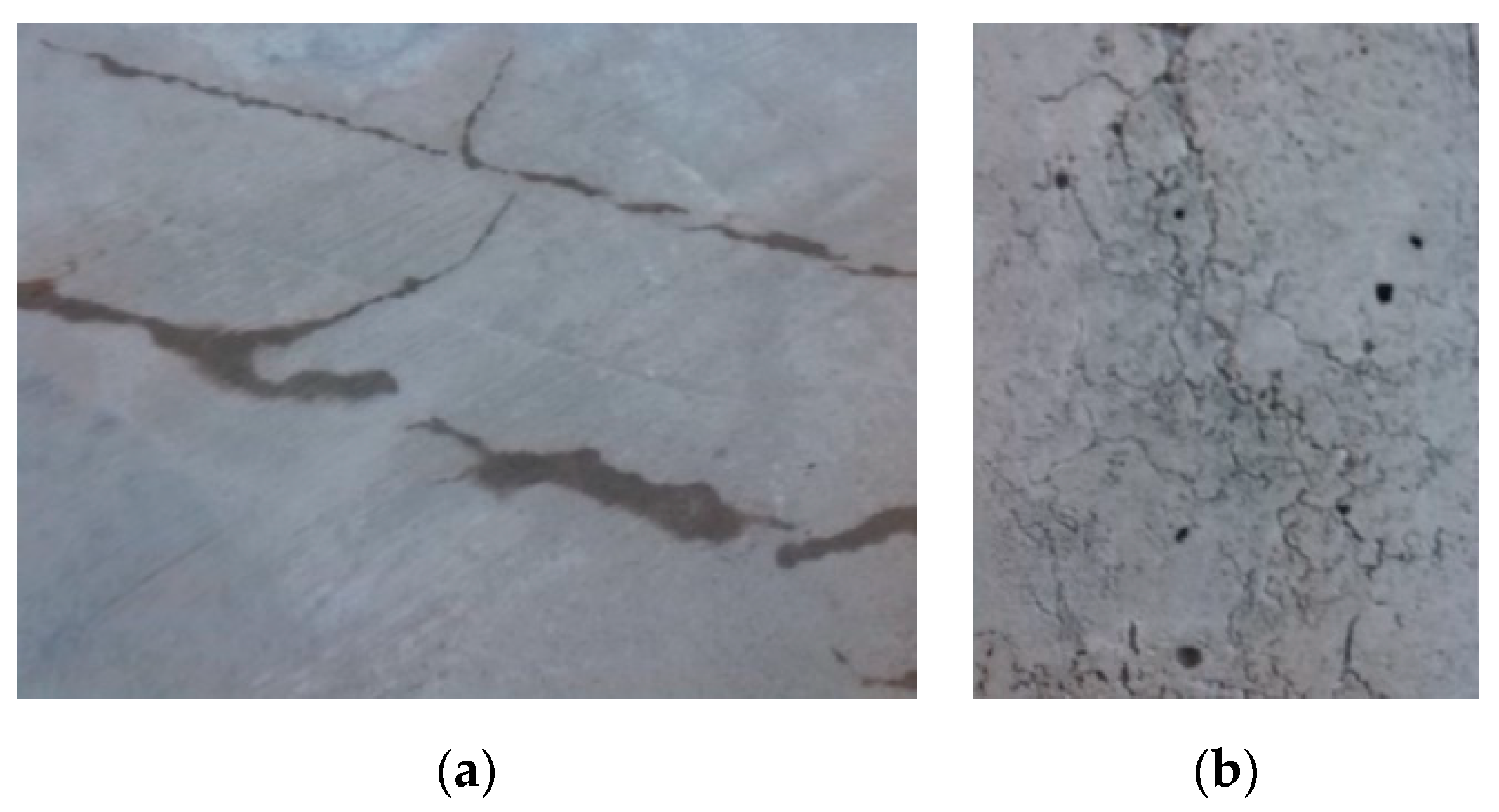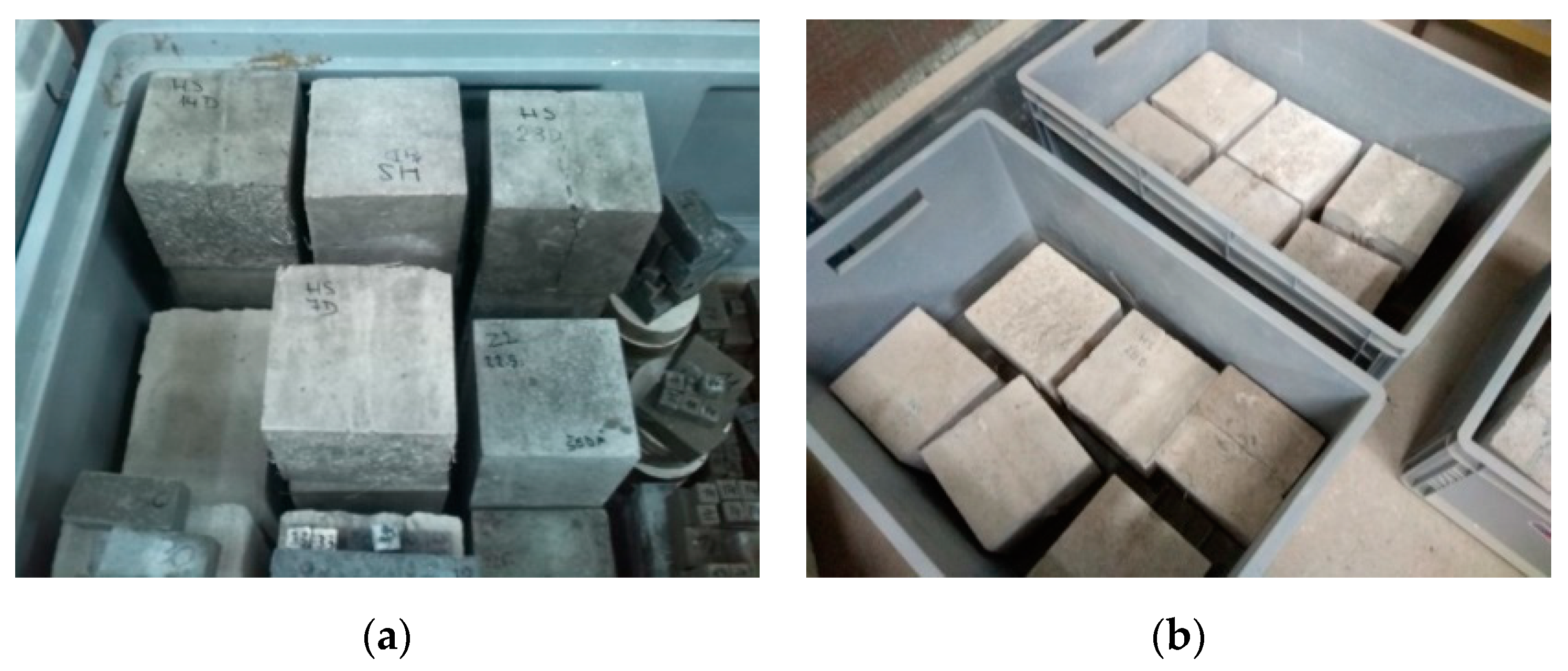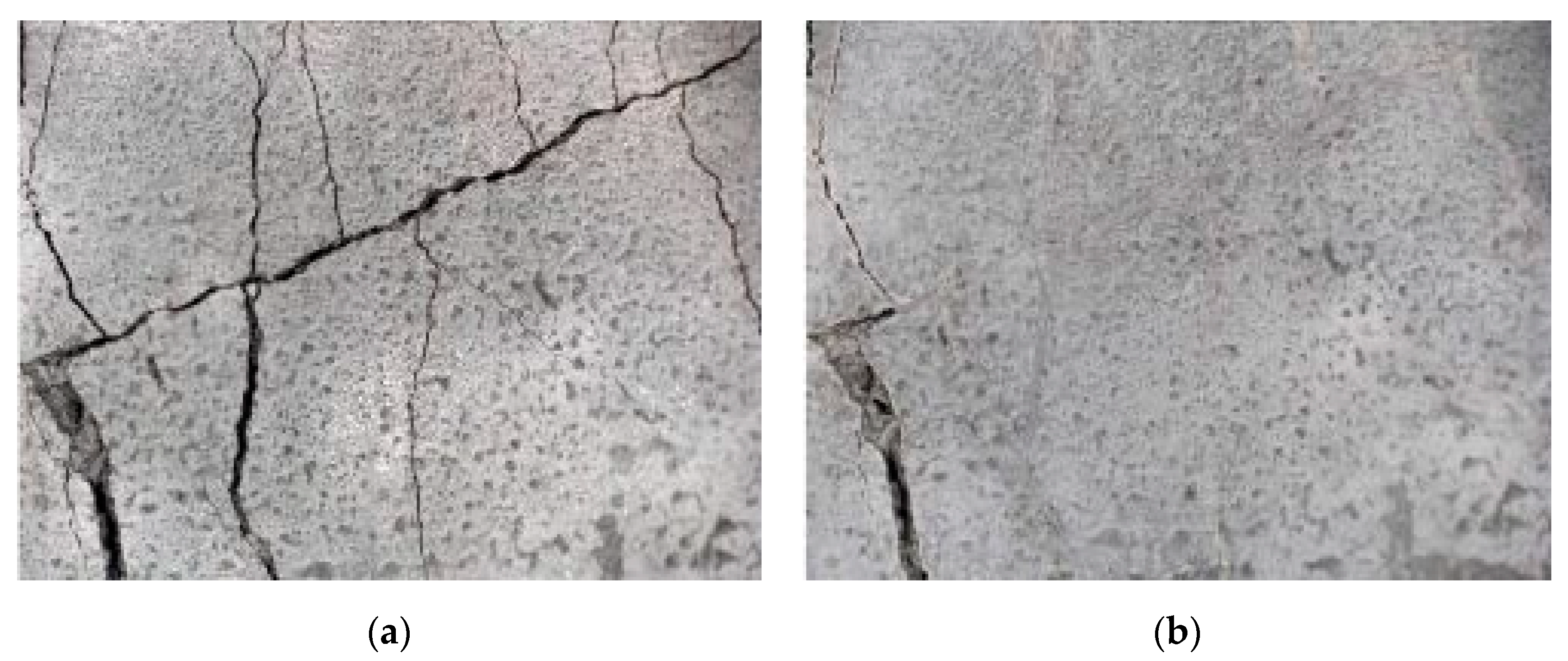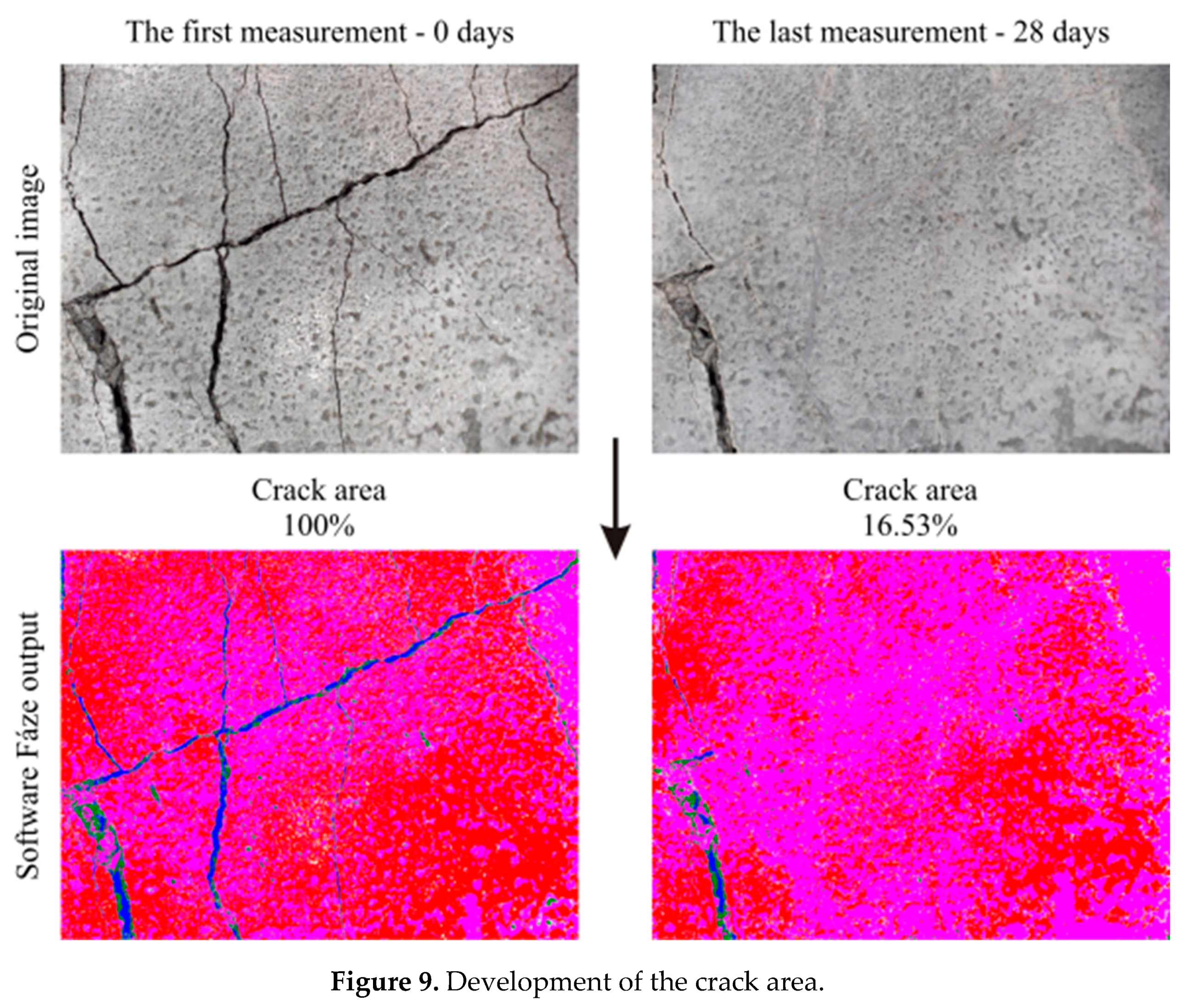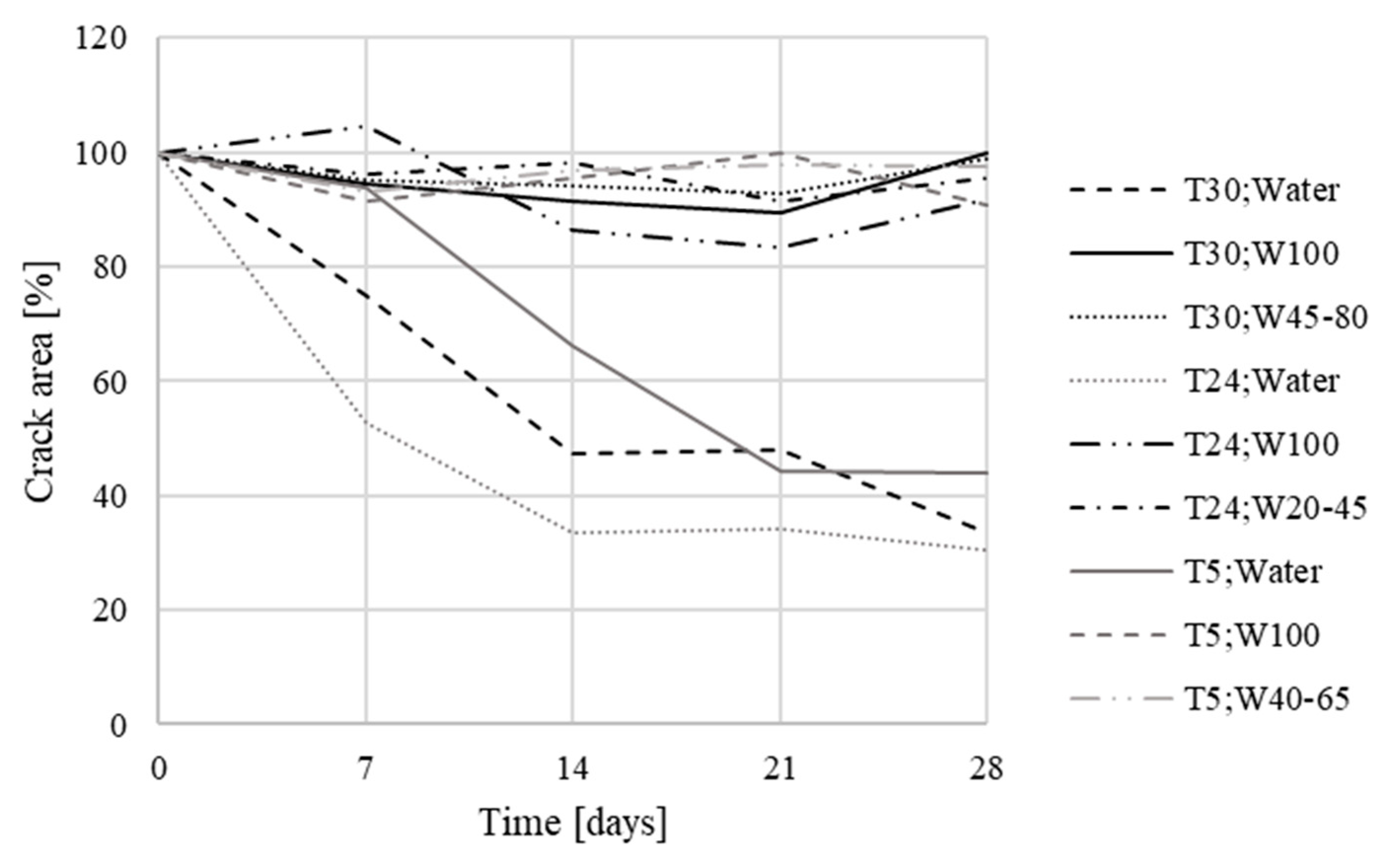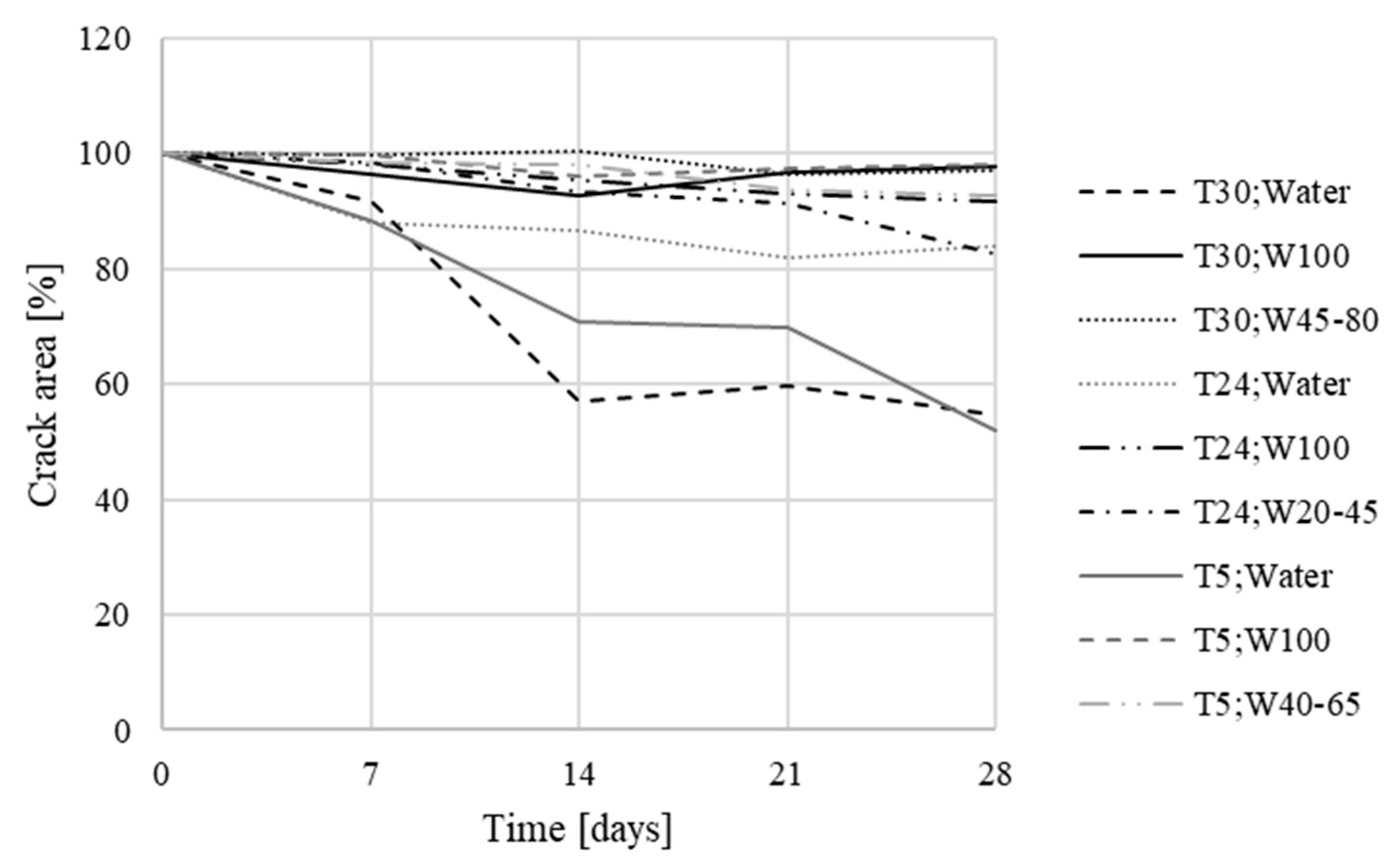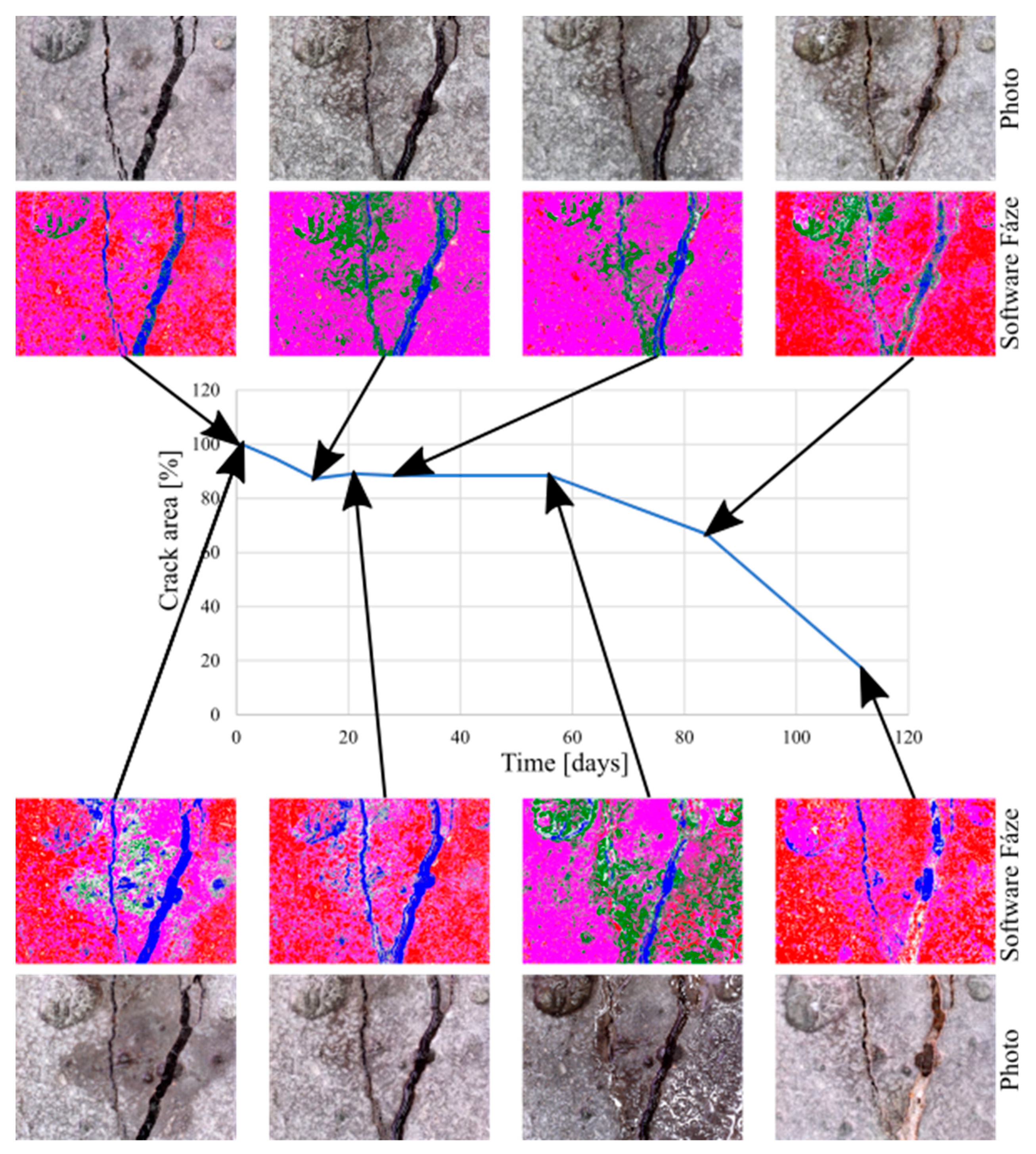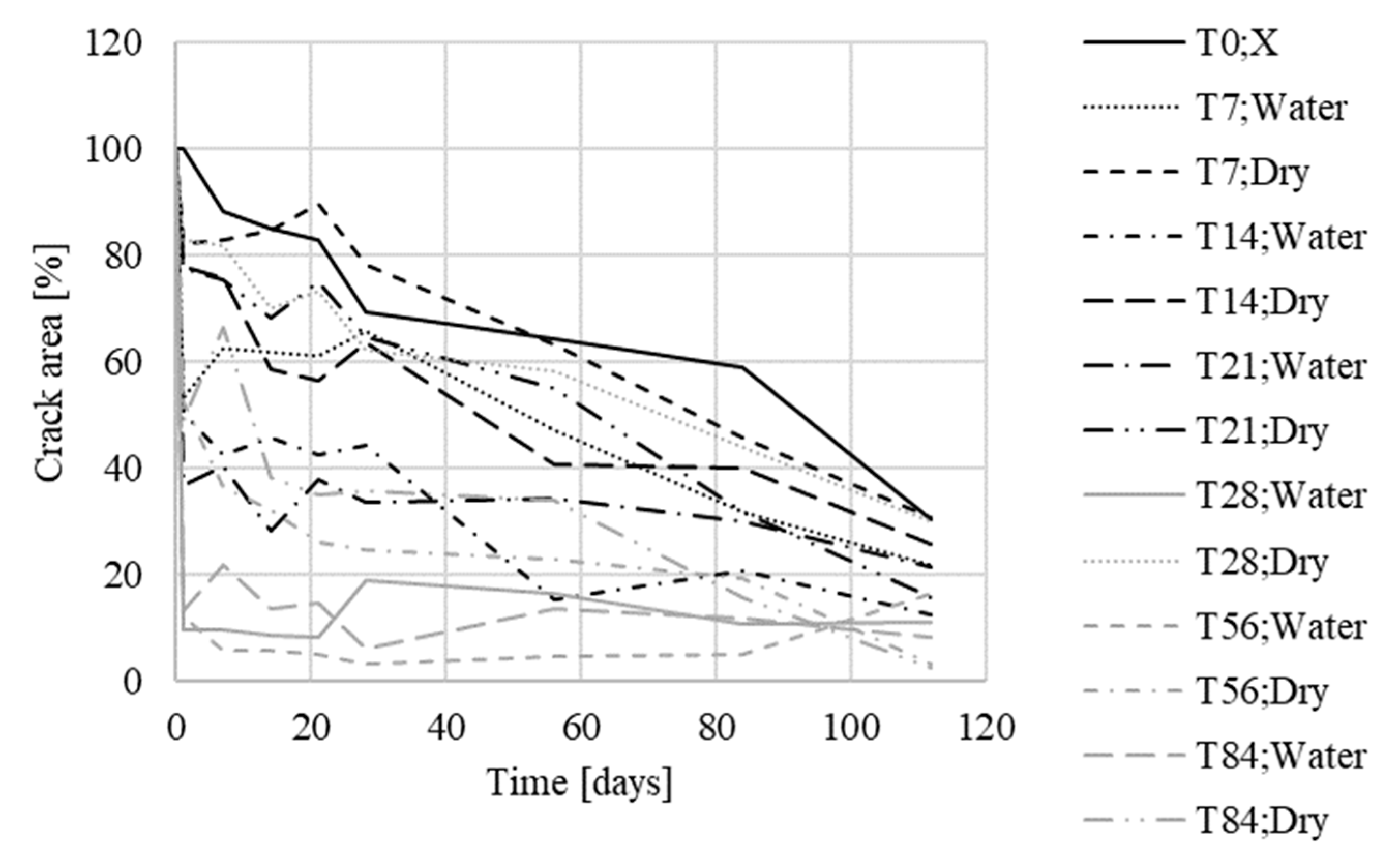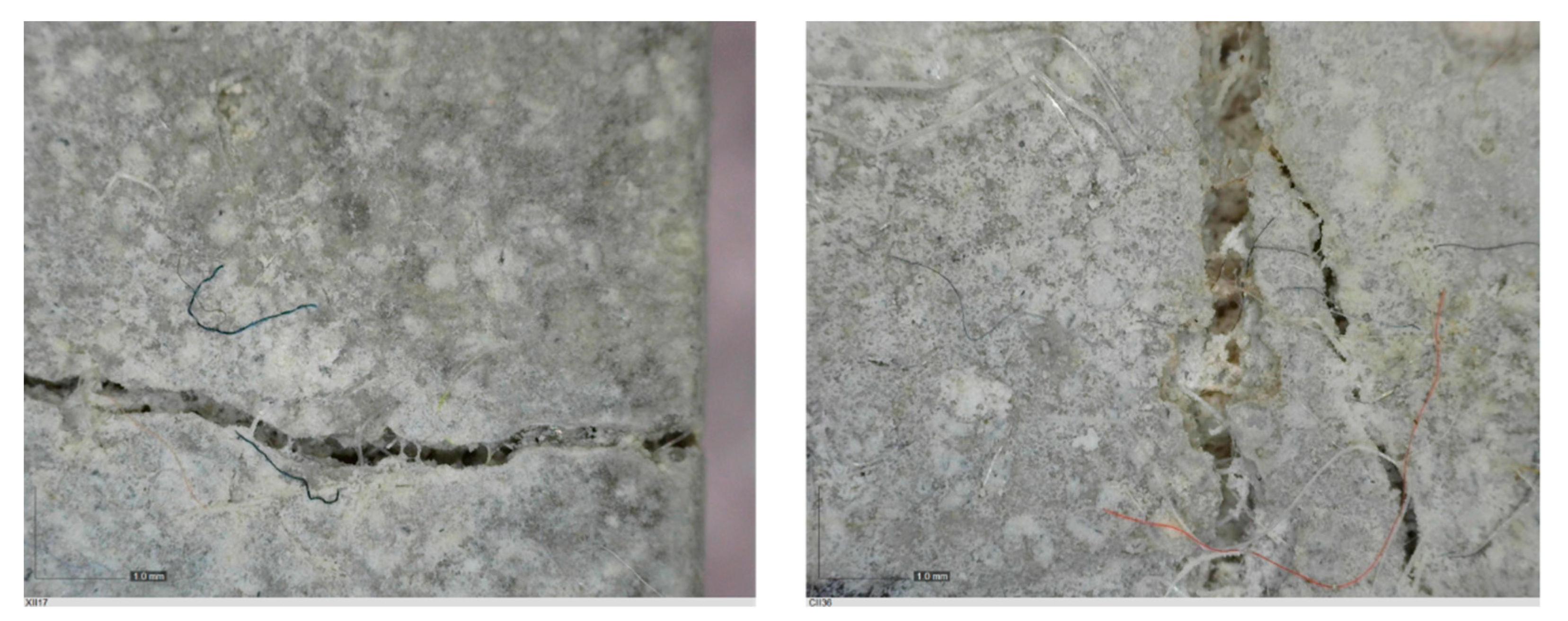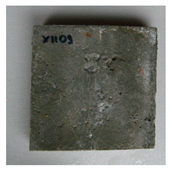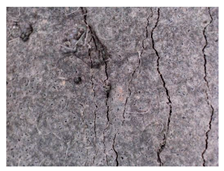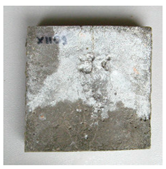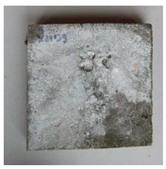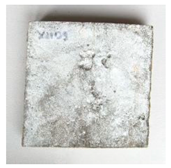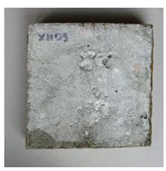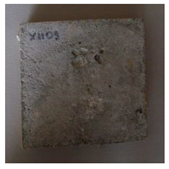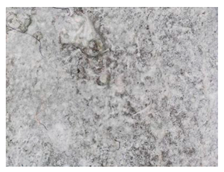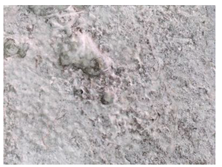2.1. Preliminary Tests on Cubes
First, the basic parameters of the improved self-healing ability (due to crystalline admixture) were tested. Pure concrete was used for this initial phase of testing.
The experiment started in November 2015 and finished in June 2018. The aim of this research was to load these cracked samples with water pressure to determine their waterproofness, in terms of the crystalline admixture’s influence on the sealing of cracks. A water pressure test, using a modified methodology according to [
41], was used.
All specimens were standard concrete test cubes 150 × 150 × 150 mm
3 [
42]. The specimens’ composition: Cement type CEM I 42.5, aggregate, and polypropylene fibers Forta Ferro (Grove, PA, USA) (
Table 1). The length of the fibers was 54 mm, and the tensile strength was 620–758 MPa. The most commonly used product in practice worldwide, Xypex Admix (Richmond, BC, Canada), was chosen as a crystalline admixture for the study. It is known that in Xypex Admix admixture are only inorganic compounds; the specific composition is know-how of the producer.
Various methods of crack creation were considered. The creation of a realistic crack (if possible) in laboratory conditions is difficult, but it was necessary for the planned experiments. If the crack in the specimen does not resemble a real crack, then the experiment is valueless. Therefore, one of the objectives was to find a method for creating a realistic crack, with a predefined width. It was found (during the development of the methodology) that it was possible to make a realistic crack, but without a predefined width, or it was possible to make an unrealistic crack, with a predefined width. The first possibility was chosen. As a result, a method based on polypropylene fibers added into the concrete mixture was chosen for making realistic cracks in the test cubes. The cracks were made using a machine for testing the tensile splitting of concrete. Thanks to the presence of fibers, the cracks were created, but the concrete specimen was not destroyed. This method allows creating specimens with cracks, but the width of the cracks could not be controlled in advance. The crack width was measured by an Electrometer 900 optical microscope. Width of the cracks was in the range of 0.05–0.8 mm.
Concrete specimens were cured under polyethylene foil for 48 h after the concrete embedment and, consequently, the formwork was stripped, and they were placed in special tanks full of water to stop autogenous shrinkage [
42]. The cracks were created 14 days after concreting.
An important side objective of the experiment was to qualify the environment for saving the specimens (in relation to the maximum efficiency of the secondary hydration process in cracks). The aim was to determine whether air is necessary to cause chemical reaction or not. The basic presupposition was that ideal conditions for the growth of crystals are a specific combination of moist and dry environment. At first, all cubes were held in tanks under the water level. Then, 45 days after embedment, the specimens were placed in tanks with a humid environment (Temperature: 20 °C; Humidity: 95%) (
Figure 2a), without direct contact with liquid water. Humidity was controlled using a device based on the Arduino UNO platform. The cubes were held in this environment for the next 65 days.
Subsequently, the cubes were placed in boxes (Temperature 20 °C, Humidity: 60%), where the level of water was maintained at 20–30 mm from the bottom (
Figure 2b). This caused capillary action through the cracks, and the subsequent evaporation of water to the environment. By this process, there was an attempt to simulate the environment of a real on-site structure.
2.2. Interaction between TRC and Improved Self-Healing Ability Caused by Crystalline Admixture
The main experiment was divided into three phases (
Table 2). The first phase was focused on the influence of temperature and humidity on the self-healing ability of concrete. The second phase was focused on the influence of time and different conditions before the exposure of the test specimens to boundary conditions (curing of the specimens in a standard laboratory environment; temperature 20 °C, humidity 60%, and under water level). The last phase was focused on determining the influence of different cement types (CEM I and CEM II) on the self-healing capacity of concrete with crystalline admixtures. This was mainly done in order to classify the results of the first and the second phase (cast with CEM II) in comparison to the preliminary test (cast with CEM I). (
Section 2.1).
The main aim of the experiment was to find out, if the crystalline admixture was able to help overgrow a large amount of the microcracks, whose formation is typical for thin structures made of TRC. This ability is important for the extension of the life of structures made from TRC.
The temperature and air humidity of the environment were measured using a thermometer and hygrometer based on the Arduino UNO platform. Measurements lasted for the whole time of the experiment duration.
The dimensions of the test specimens were 100 × 100 × 10 mm
3 (the first phase) and 50 × 50 × 10 mm
3 (the second phase and the third phase). The composition of all test specimens in all phases was the same (
Table 3). For all test specimens in all phases, nonwoven polypropylene fabric, FILTEK (Jinan, China),, with a density of 200 g/m
2 was used. The tensile strength lengthwise was 12 kN/m
2, and transverse tensile strength was 7.5 kN/m
2. There were two layers of polypropylene fabric in each test specimen, placed on both surfaces (distance from surface was 0.1 mm). The water–cement ratio was 0.4, this was caused by using fine aggregates and the polypropylene fabric.
In the first phase, 9 test specimens were produced, in the second phase, 56 test specimens were produced, and in the third phase, 6 test specimens were produced containing a crystalline admixture (Xypex). The same quantity of reference specimens was produced as well.
The test specimens were cured for two weeks, during which they were covered with a polyethylene foil to prevent the evaporation of moisture into the environment. During the curing, the temperature and humidity of the surrounding environment were monitored continuously by the Arduino UNO platform (Ivrea, Italy). Cracks were made by applying a bending load. The maximum crack width was about 0.1 mm, and the measurement of all crack widths was performed with a DigiMicro Profi II digital microscope (Leer, Germany), (
Figure 3).
In the first phase, the test specimens were placed in an environment with different boundary conditions (
Table 4).
The crack development was monitored for the next 4 weeks, with control imaging every 7 days using the DigiMicro Profi II microscope (Leer, Germany). For specimens placed in direct contact with water, evaporation was allowed to the surrounding environment with ordinary relative humidity (40–80%). For specimens placed in the environment with a 100% relative humidity, a decrease in humidity values can be observed at regular intervals. This reduction was caused by regular monitoring of the test specimens, which were removed from their environment for a short time for the purpose of photographic documentation.
The aim of the second phase was to determine the effect of curing on the activation of the crystalline admixture in concrete.
Initial imaging was performed using the Digi Micro Profi II microscope at 50× magnification, and the specimens were placed in different environments based on a predetermined experimental scheme (
Figure 4). The numbering of the test specimens with the Xypex admixture and the reference test specimens was always the same depending on the environment which was used. For each specimen, the same area was always captured by the microscope for the duration of the experiment.
The test specimens were divided into sets of four test specimens. The first two sets (test specimens 1–8) were placed immediately in the environment where the water level was maintained throughout the experiment so that the upper surface of the specimens was in contact with air (
Figure 5). The remaining sets of test specimens were divided in half, the first half were fully submerged under the water level, and the second half were kept under laboratory conditions (temperature of around 25 °C, relative humidity of around 60%) without contact with liquid water. Subsequently, the two sets of test specimens were put in evaporation tanks; one in the water tank, and the other placed in laboratory conditions (temperature of around 25 °C, relative humidity of around 60%) without contact with water. The specimens were put in evaporation tanks at different time intervals: 7 days after the start of the experiment, after 14 days, 21 days, 28 days, 2 months, and 3 months. (
Figure 6).
The last phase was focused on comparing the effectiveness of the crystalline admixture depending on the type of used cement. Two types of cement were tested, CEM I (
Table 5) in the preliminary test, and CEM II in the first phase and the second phase.
A total of 12 test specimens with dimensions of 50 × 50 × 10 mm3 were produced, i.e., a total of two sets of test specimens of three pieces each for each type of cement, and the corresponding number of reference specimens, were made.
